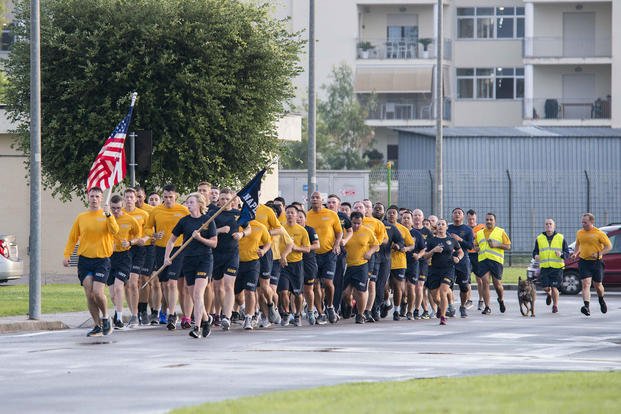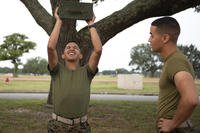There are mainly two types of runners with two main types of training programs: running fast for short distances and long-distance runners who are slower.
As discussed in the article about energy systems, those two styles of running are assisted by two different types of fuels in our body. The faster style requires the immediate energy of glycogen and carbohydrates, and the slower style can burn slower, using the fats stored in our body.
Whether you are into long, slow-distance running or high intensity interval training (HIIT), it is likely you will have to make some sort of compromise as you start training for timed runs in the military. Depending on the competitive nature of the program you select, competitive timed runs will be too long to sprint and too short to jog slowly.
Which training way is better?
Can you get fast timed runs (above average passing) in the military by doing more sprints than distance? Yes, you can.
Can you get fast timed runs (above average passing) in the military by getting good at long-distance runs? Yes, you can.
Can you mix the two options together in a training program and do it faster? Yes, you can.
That is the compromise both runners have to yield to when preparing for the type of running events experienced in the military. The problem typically lies with the speed or pace the runner is using during the workouts as to what is more effective in a shorter period of time.
It also depends on the distance of the timed run in the military. As you know, 1.5 miles, two miles and three miles are the distances, depending upon the branch of service. There are also longer distances in special-ops programs such as four-, five- and six-mile runs (and rucks). These two factors (distance and pace) will continue to challenge any runner -- fast or slow -- preparing for timed runs.
Most calories?
If calorie burning is your goal and you only have 30 minutes, you will burn more calories in 30 minutes of sprinting and leg PT, compared to just jogging 30 minutes. Depending on your goals, that could be a factor, but sprinting or fast running daily is not the answer, either. You can mix in some fast interval training in the pool, bike or rowing machine between those running days.
For the tactical athlete
You may not consider yourself an athlete, but if you are in the military, police or firefighting communities where you may be placed in dangerous work situations that you must rely on your fitness ability to survive, you are a tactical athlete.
In the running world, there is the cardiovascular endurance benefit from running longer distances, the speed benefit from doing sprints or very fast-paced running, and the agility benefits from sudden changes of direction, climbing and jumping.
As a tactical athlete, you need all of the above, plus the added benefit of strength, grip and load-bearing activities involved in rucking and carrying equipment for long distances. When you realize you need all of the above elements of fitness to be a well-rounded tactical athlete, you realize that your training program needs to have short and fast running days (sprints and agilities or obstacle courses), goal pace running days (testing) and longer-distance running or rucking days. All require a progression that is logical to start with and increase in speed, time, distance and weight from week to week.
Sample beginner, intermediate and advanced level programming and progressions
Beginner running with 10%-15% weekly progression (mileage or time):
| Day 1 | Day 2 | Day 3 | Day 4 | Day 5 |
| Run 1 mile steady | Run 4 x 400m fast | Option to do non-impact cardio bike / elliptical / swim / row for 20 min | Run 1 mile fast | Run 2 x 800m |
The 10%-15% weekly progression applies throughout your running mileage journey. After 4-5 weeks, you will be in a solid foundation of running for timed run events. Also, remember to replace any day with a mobility day or non-impact cardio day if you are feeling the aches and pains that can accompany running.
Intermediate running plan (after beginner buildup to 10 miles per week)
| Day 1 | Day 2 | Day 3 | Day 4 | Day 5 |
| Run 2-3 miles steady | Run 8 x 400m at goal mile pace for timed runs*
plus 100m fast runs x 4 |
Run 2 miles fast or 20 min non-impact cardio | Run or ruck 2 miles (10-20% bodyweight in back pack or weight vest)** | 8 x 400m runs at goal mile pace*
then 2 x 800m runs at goal pace. |
**Note: It is not recommended to start rucking without building a foundation of running of at least 10 miles per week. See rucking progression article.
Advanced running plan with higher mile running and rucking
| Day 1 | Day 2 | Day 3 | Day 4 | Day 5 | Day 6 |
| Run 4-5 miles timed -- work on fast pace not slow place | Run 1 mile warmup
- Run 400m x 10-12 at goal mile pace Cooldown jog or bike/mobility |
Ruck 25% of your bodyweight 4-5 miles | Mobility Day
Non-impact cardio plus stretch and foam roller |
Run 1 mile warmup
- Run 400m x 10-12 at goal mile pace Cooldown jog or bike/mobility |
Easy Run Day of your choice or non impact options 5-6 miles easy -- mix in a fast timed run distance though |
*Each week also will have a 10%-15% progression until you have reached your weekly mileage goal.
The above running charts are just suggestions on how to use the variety of running workouts available to you. You can add in obstacle course runs, hills, bleachers, shuttle runs or soft sand runs to your workout day, depending on your future goals and current abilities.
Warning: Most people get injured doing one of two things
1. Running too much (without a logical progression)
2. Running too fast (sprinting full speed)
These two errors in training will yield a majority of all training injuries, so be mindful.
Stew Smith is a former Navy SEAL and fitness author certified as a Strength and Conditioning Specialist (CSCS) with the National Strength and Conditioning Association. Visit his Fitness eBook store if you’re looking to start a workout program to create a healthy lifestyle. Send your fitness questions to stew@stewsmith.com.
Want to Learn More About Military Life?
Whether you're thinking of joining the military, looking for fitness and basic training tips, or keeping up with military life and benefits, Military.com has you covered. Subscribe to Military.com to have military news, updates and resources delivered directly to your inbox.















